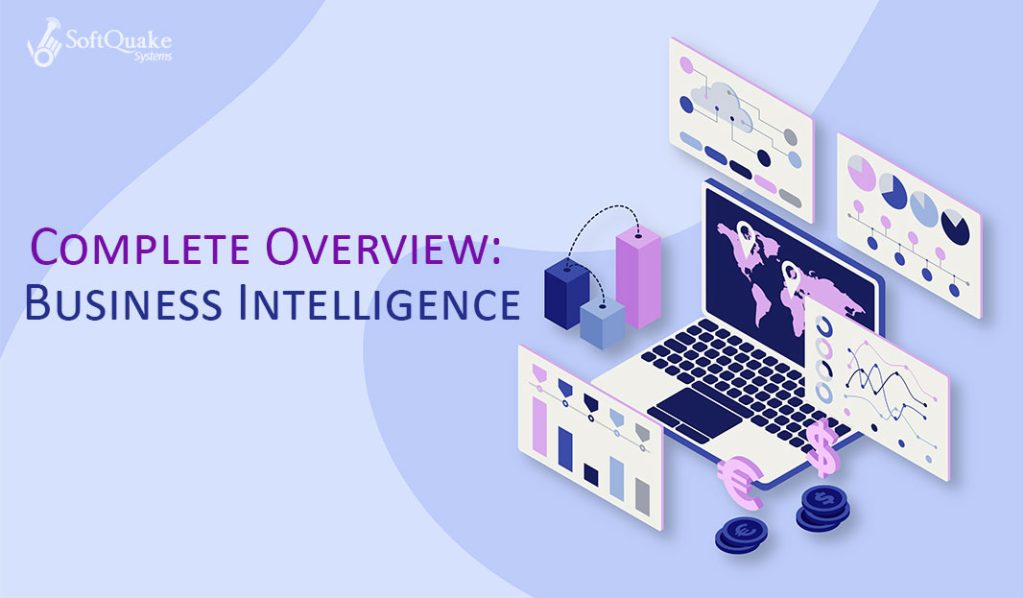
Business intelligence (BI) is essentially the umbrella term for the technologies, processes, and methods used to gather, store, analyze, and interpret data. The goal is to transform raw data into actionable insights that inform better business decisions.
Think of it as a toolbox for making sense of all the information your company generates through its operations. BI tools can analyze everything from sales figures and customer interactions to website traffic and social media sentiment.
Importance of Business Intelligence:
- Informed Decision-Making: BI provides valuable insights into business operations, market trends, and customer behaviour, enabling organizations to make data-driven decisions.
- Competitive Advantage: By leveraging BI tools, companies can identify opportunities for growth, optimize processes, and stay ahead of competitors.
- Enhanced Efficiency: BI streamlines data collection and analysis processes, leading to improved efficiency and productivity within the organization.
- Improved Performance: With BI, organizations can track key performance indicators (KPIs) and monitor their performance in real-time, facilitating continuous improvement.
- Customer Satisfaction: BI enables companies to understand customer preferences and behavior, leading to better products, services, and customer experiences.
Advantages of Business Intelligence:
- Data-Driven Decisions: BI enables organizations to base decisions on solid data rather than intuition or guesswork.
- Improved Visibility: BI provides a comprehensive view of business operations, allowing stakeholders to identify patterns and trends.
- Cost Savings: By optimizing processes and resources, BI can help reduce costs and improve profitability.
- Forecasting and Planning: BI tools facilitate forecasting and long-term strategic planning by providing insights into future trends and opportunities.
- Risk Management: BI helps organizations identify and mitigate risks by providing early warnings and predictive analytics.
Disadvantages of Business Intelligence:
- Cost and Complexity: Implementing BI systems can be expensive and complex, especially for small and medium-sized businesses.
- Data Quality Issues: BI relies on accurate and reliable data, and poor data quality can lead to incorrect insights and decisions.
- Resistance to Change: Employees may resist adopting BI tools and processes, especially if they perceive them as a threat to their job security or autonomy.
- Security Concerns: BI systems store and analyze sensitive business data, making them potential targets for cyber attacks and data breaches.
- Overemphasis on Data: Relying too heavily on data analysis can lead to decision paralysis or tunnel vision, ignoring other important factors.
Future of Business Intelligence:
- AI and Machine Learning: The integration of AI and machine learning algorithms will enable BI systems to automate data analysis, prediction, and recommendation processes.
- Real-Time Analytics: There will be a shift towards real-time analytics, allowing organizations to respond quickly to changing market conditions and customer demands.
- Natural Language Processing (NLP): BI tools will become more user-friendly through the incorporation of NLP, enabling users to interact with data using everyday language.
- Data Democratization: There will be a trend towards making BI tools and insights accessible to a wider range of users within organizations, democratizing data access and analysis.
- Embedded BI: BI capabilities will be embedded directly into business applications and workflows, making data-driven insights more readily available to users.
Challenges in Implementing Business Intelligence Strategy:
- Data Integration: Integrating data from multiple sources can be challenging, especially if they are disparate or incompatible.
- Change Management: Overcoming resistance to change and ensuring user adoption of BI tools and processes can be a major challenge.
- Data Governance: Establishing data governance policies and ensuring data security, privacy, and compliance are critical for successful BI implementation.
- Skills Gap: Organizations may lack the necessary skills and expertise to effectively implement and utilize BI systems.
- Scalability: BI systems need to be scalable to accommodate growing data volumes and user demands over time.
Business Intelligence Tools and Systems:
- Tableau: A popular data visualization tool that allows users to create interactive dashboards and reports.
- Microsoft Power BI: A suite of business analytics tools that enables users to visualize and share insights from their data.
- QlikView/Qlik Sense: Business intelligence and data visualization platforms that offer self-service analytics capabilities.
- SAP BusinessObjects: An enterprise reporting and analytics platform that provides tools for querying, reporting, and data visualization.
- IBM Cognos: A business intelligence and performance management software suite that includes reporting, analysis, and dashboarding capabilities.
Examples of Business Intelligence:
- Retail Analytics: Retailers use BI to analyze sales data, customer demographics, and inventory levels to optimize pricing, promotions, and product assortments.
- Financial Analysis: Banks and financial institutions use BI to monitor market trends, analyze risk, and detect fraudulent activities.
- Supply Chain Management: Manufacturers and logistics companies use BI to track shipments, optimize routes, and manage inventory levels.
- Healthcare Analytics: Healthcare providers use BI to analyze patient data, identify trends in diseases, and improve clinical outcomes.
- Customer Relationship Management: Companies use BI to analyze customer data and behavior, personalize marketing campaigns, and improve customer satisfaction and retention.
Conclusion:
Business Intelligence plays a crucial role in helping organizations gain insights from their data to support decision-making, improve efficiency, and maintain a competitive advantage. While BI offers numerous advantages, its implementation can also pose challenges related to cost, complexity, and user adoption. However, with advancements in technology and continued investment in BI capabilities, the future holds promising opportunities for organizations to leverage data for strategic advantage.


 +91 8420731759
+91 8420731759














